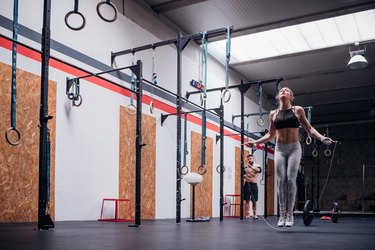
While calf raises and jumping rope both strengthen your gastrocnemius and soleus muscles, these exercises have fundamental differences. One builds strength, while the other boosts endurance.
Calf raises utilize force production over a progressive resistance to challenge your muscles. Jumping rope is an aerobic activity that trains not only your muscles but also your cardiorespiratory systems.
Video of the Day
Video of the Day
A good workout program will develop your whole body — skeletal and cardiovascular systems, as well as utilize both of these types of exercises.
Type of Activity
A calf raise exercise is considered resistance training, while jumping rope is an aerobic activity. Resistance exercise is anaerobic, meaning your body does not need oxygen to produce the energy for the movement. This type of activity is unsustainable for an extended time as it is high intensity and, generally, short in duration.
Jumping rope is a more sustainable activity that increases your heart rate and blood flow to accommodate growing energy needs. Your body produces the energy for jumping rope using oxygen.
How Muscles Adapt
The way your muscles and the rest of your body adapt to these two exercises varies. Jumping rope can be considered endurance training, meaning jump rope benefits also include boosting heart and lung health. This type of low-intensity, high-frequency activity results in metabolic changes inside your muscles.
Endurance training increases the capability of your muscle mitochondria. The mitochondria is the place inside your muscle where energy is made with oxygen. This adaptation means that your body is able to produce a greater amount of energy with the same given amount of oxygen.
The larger force production occurring with calf raises can lead to changes in the physical size of your skeletal muscles. As you progressively challenge your muscles with exercises such as barbell calf raises, they begin to hypertrophy, increasing in cross-sectional size.
Jump Rope Muscles
The muscles you use for each exercise are different, yet similar. Jump rope muscles are recruited throughout your body but include the muscles used during the calf raise. When you do a calf raise, you are targeting your gastrocnemius and soleus muscles. Jumping rope works many leg muscles, including your gastrocnemius, soleus, quads, glutes, hamstrings and hip adductors. Core muscles are also recruited to keep your torso stable as you jump.
Read more: How Much Should I Jump Rope a Day?
Vary Your Workouts
Forming your workout varies with the jump rope and calf raise exercise. When you do an aerobic exercise like jumping rope, you aim for time over repetitions. A minimum of 150 minutes of moderate-intensity or 75 minutes of vigorous intensity aerobic activity should be performed each week, according to the Centers for Disease Control and Prevention.
A resistance exercise, like the calf raise, is set up as sets and repetitions. For overall muscular gains in strength, aim for doing three sets of eight to 12 repetitions, three days per week, on alternating days. The CDC recommends that strength training exercises be performed at least two times per week.
Was this article helpful?
150 Characters Max
0/150
Thank you for sharing!
Thank you for your feedback!